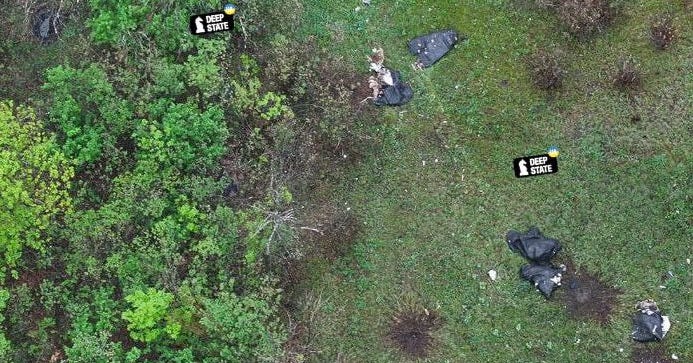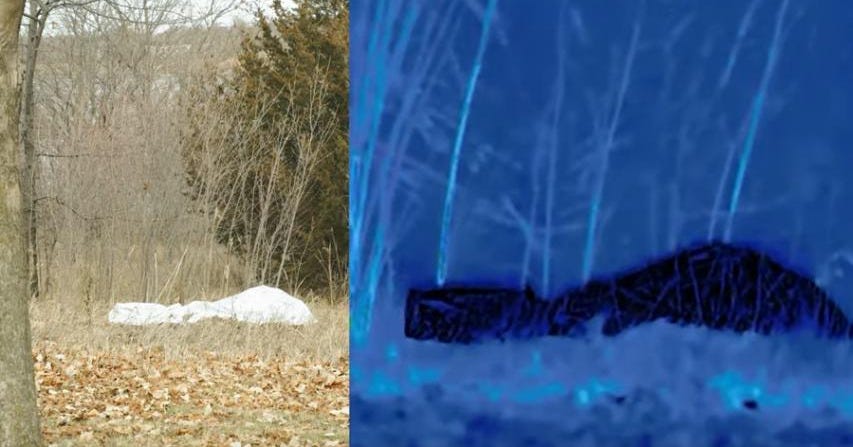A Heat-Trapping 'Bag of Farts' Can Protect You From Ukraine's Deadly Night Drones. But It'll Cost You $400.
Cheaper thermal blankets give you away.
The Ukrainian Deep State analysis group obtained a photo graphically illustrating what happens when desperate Russian troops execute a good idea—but badly.
The good idea, as they sneaked toward the front line at night, was to camouflage themselves to avoid the lethal attention of Ukraine’s tiny explosive drones. The bad idea was to use very cheap thermal blankets for camo. “Something went wrong,” Deep State quipped.
The photo, apparently depicting the morning aftermath of the Wednesday night massacre of a Russian infantry group, reveals multiple impacts from explosives-laden first-person-view drones—and five or six discarded thermal blankets, some potentially concealing dead Russians. A second photo depicts five sprawled Russian bodies.
The night still offers some protection from the hundreds of thousands of tiny drones that swarm the 700-mile front line of Russia’s 39-month wider war on Ukraine.
But less and less. Night-fighting troops are coming to realize they’re at risk of getting droned by FPVs fitted with thermal sensors—or by bigger “vampire” drones with night-vision and payloads of small gravity bombs.
As drones evolve, and the expanding drone industry drives down costs, the night is becoming much less safe. It’s not for no reason that when one group of Russian infantry moved toward positions held by the Ukrainian army’s 63rd Mechanized Brigade near the city of Lyman on Wednesday night, the Russians draped thermal blankets over their shoulders.
A thermal blanket should, in theory, mask a person’s heat signature by trapping the heat under it—and hide the wearer from any observing drones with night-capable infrared sensors. The problem is that cheap thermal blankets actually work too well.
The 63rd Mechanized Brigade’s night-vision FPV drones easily spotted the approaching Russians not by their heat, registering as bright spots on the drones’ infrared sensors, but by their lack of heat—the cold spots among the surrounding foliage.
A barrage of FPVs rained down on Russians who almost certainly couldn’t see the lethal self-exploding robots coming. The “funny occupiers in the Lyman region … put on anti-drone raincoats and thought that now they are safe,” the 63rd Mechanized Brigade joked.

False economy
Thin Line Defense Co.’s comparison of a $400 thermal blanket versus a $4 thermal blanket illuminates what happened that apocalyptic night in Donetsk. Hiding under the pricier blanket among the trees, the tester disappeared on a drone’s heat sensor.
“You can blend in with the heat of the tree itself to hide your signature with the thermal blanket,” they explained. “We should, uh, definitely be able to hide from a drone with this bag of farts.”
The cheaper mylar blanket did not blend in. Instead, it marked the tester with the same cold signature that gave away those unlucky Russians. “Our drone starts panning and looking for us trying to see if we’ve somehow disappeared in the trees—and nope there we are, a big huge-ass stupid bag behind a tree on thermal,” the tester reported. “It’s just this obviously black metallic thing.”
The lesson is undeniable. You can hide from a night drone. But it’ll cost you $400. Try doing it for $4, and you might wind up like the Russian infantry the 63rd Mechanized Brigade apparently left rotting under their thermal blankets on that field in Donetsk.
Read more:
Russian Troops' Cheap Thermal Blankets Worked Too Well. Their Cold Signatures Gave Them Away to Ukraine's Drones.
The dark still offers some protection from the hundreds of thousands of tiny drones that cloud the sky over the 700-mile front line of Russia’s 39-month wider war on Ukraine.






